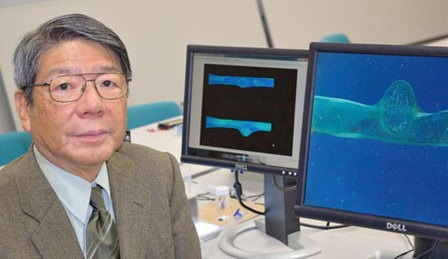
Makoto Negoro, professor, Fujita Health University, School of Medicine, Toyoake-Nagoya, Japan, tells NeuroNews that simulation-based training is beginning to receive great attention in surgery and endovascular intervention. He says the simulator, called EVE, which takes its initials from EndoVascular Evaluator, is able to analyse the process and the result of an intervention performed by a trainee.
Why is the new system important?
The rapid development of neurointervention has increased the need for training opportunities. Even today, training in neurointervention still relies on direct mentoring by experienced doctors (the so-called traditional apprenticeship model). However, changes in clinical practice have precipitated concerns over patient safety which has compelled the creation of new training systems. Various models have been proposed as simulators for neurointervention. A variety of models, including living animals or inanimate models, human cadavers and virtual reality, have been used to simulate human tissue and anatomy. Our new system has distinctive features, a patient-specific three-dimensional model of the human cerebral artery reproduced from CT and MRI with real precision. This model reproduces an exceedingly realistic feel, dynamic vascular deformation and other important aspects involving endovascular intervention. It could provide effective platforms for applications, such as diagnostic or therapeutic planning, haemodynamic analysis, evaluation of new devices and training. This simulator is the result of joint research between physicians and the Department of Engineering, Nagoya University, Nagoya, Japan.
How does it work?
This vascular model is made of elastic transparent silicone that recreates the elasticity and friction of human vasculature, simulating the sensation and behaviour of catheter manipulation during neurointervention. It could be connected to a rotary or pulsatile pump circulating the fluid with pressure, flow and temperature simulation of human body. Trainees can simulate the endovascular procedure under either digital subtraction angiography or direct observation without radiological equipment. The actual devices used in real procedures (catheters, wires, balloons, coils and so on) can be used during simulation. It is possible for trainees to feel the catheters and guidewire interaction (push-pull or rotation). Models of human intracranial aneurysms are made by the same technology and can be employed for simulation for aneurysm embolisation.
How do trainees benefit, and at what level?
The trainees at novice level are able to acquire the basic technique of neurointervention, such as guiding a catheter into carotid artery through the aortic arch and navigating a microcatheter inside intracranial vessels. The mastery of basic techniques allows trainees to steepen their learning curve.
The effectiveness of simulation training for beginners has been demonstrated in other surgical procedures such as laparoscopy, and even experienced neurointerventionalists are able to gain a significant advantage in conducting a rehearsal before difficult procedures.
EVE is able to analyse the process and the result of the intervention, namely, the trainee’s skill, as its name indicates.
What is your message to neurointerventionalists?
Simulation-based training is beginning to receive great attention in surgery and endovascular intervention. The effectiveness of computer-based simulators (virtual reality) has been well recognised. Virtual reality allows for better incorporation of varied anatomy from patients. On the other hand, this simulator (EVE) is superior in mimicking device behaviour during real cases. Both virtual reality and EVE work together and should be synergistic from the educational point of view. Such simulation-based education should be included as a part of neurointerventional training system.













